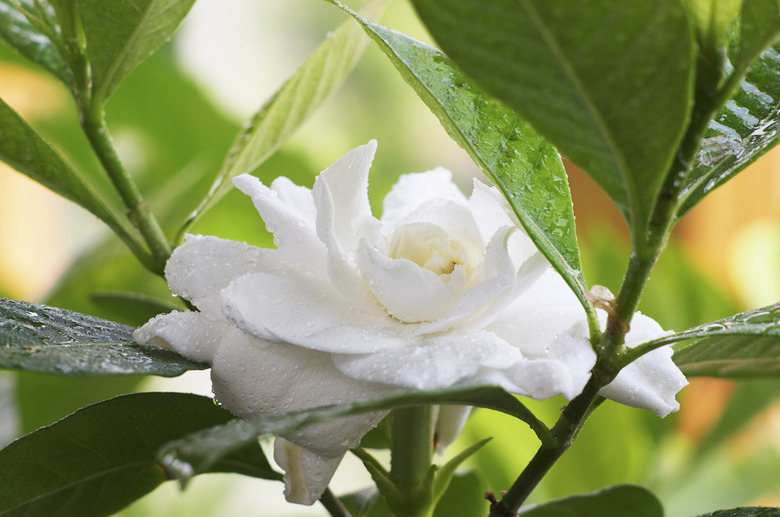How To Get Rid Of Insects On Gardenias
Learning how to get rid of insects on gardenias (Gardenia jasminoides, USDA zones 7 through 11) can help your plants thrive. One gardenia blossom fills an entire room with fragrance. So imagine the power of a mature gardenia shrub, some 8 feet tall and wide, its shiny, bright-green leaves covered with snow-white blossoms. With this drawing power, it's little wonder the plant attracts pests, including aphids, scale insects, whiteflies and thrips. Just as your gardenia needs you to perform regular pruning and care, it also needs you to protect it from insects.
Battling Aphids on Gardenias
Battling Aphids on Gardenias
Only 1/8 inch long, an aphid has mouth parts that are powerful enough to pierce a leathery gardenia leaf and suck its sap, causing it to shrivel and distort. An infested plant becomes weak, and its blossoms decrease. An aphid is never alone; look on leaves or stems for its pals.
Start with a garden hose to spray the bugs off the leaves with water. If that isn't enough to get rid of insects on gardenias, spray with a 1 or 2 percent mixture of horticultural oil three times at five- to seven-day intervals, or according to label directions. For example, combine 2 1/2 tablespoons of horticultural oil with 1 gallon of water to create a 1 percent solution and mix 5 tablespoons of horticultural oil with 1 gallon of water to make a 2 percent solution.
It's always wise to water the gardenia well before spraying because a drought-stressed plant can suffer foliar damage after it is sprayed. Spray the mixture with a garden sprayer late in the day when the temperature is under 90 degrees but above 45 degrees Fahrenheit. This spray kills by suffocation. So keep spraying until the product drips from the gardenia's foliage.
Tackling Scale Insects
Tackling Scale Insects
Don't be embarrassed if you mistake scale insects for parts of the gardenia plant or a disease symptom. They don't look like normal bugs at all and are easy to miss when getting rid of insects on gardenias. Female scales are completely immobile, clinging to a plant (some underneath an armorlike covering and, similar to aphids, use their mouth parts to pierce the plant and suck its sap.
Remedies for scale insects are similar to those for an aphid infection. Wash the bugs off the plant with water or wipe them off, apply a 1 or 2 percent mixture of horticultural oil and encourage predator insects, including ladybugs and parasitic wasps. Horticultural oil is a safe, proven product for scale control. Use the oil in early spring to get rid of overwintering bugs and then spray again when new leaves appear in spring. Spray twice more at six-week intervals.
Beating Back Whiteflies
Beating Back Whiteflies
Another tiny, sucking insect, a whitefly is not really a fly but closer to a scale insect. Immature whiteflies look like scales whereas the mature bugs resemble small, white moths. The same treatments that work for aphids and scale insects also get rid of whiteflies, including hosing off the plant's leaves with water and encouraging the same predator insects. Horticultural oil spray is also effective for whiteflies when used three times at five- to seven-day intervals.
Controlling Thrips on Gardenias
Controlling Thrips on Gardenias
You won't see thrips without a magnifying glass, but you'll see the damage they cause your gardenia. Like the other major gardenia pests, 1/16-inch-long thrips suck the sap, causing stunted buds and curled foliage. Your best course of action is to encourage natural predator species to polish off your thrip population. Because insecticides kill off these predators too, avoid them. Also use good cultural practices, including mowing down all high weeds and grass near your gardenia plant.
Managing Spider Mites
Managing Spider Mites
Just like the spiders for which they are named, spider mites are not real insects. They're arachnids with eight legs instead of six, and they're about 1/50 inch long. They suck gardenia sap and can be repelled by the same means that repel aphids. Insect predators generally keep a spider mite population in line, but you also can get rid of spider mites by spraying the gardenia foliage with water from a hose or by spraying horticultural oil on them.
